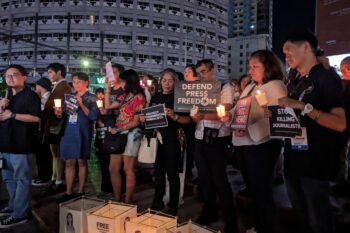 The dengue-carrying Aedes egypti mosquito, so full. With my blood? MindaNews photo by BOBBY TIMONERA
The dengue-carrying Aedes egypti mosquito, so full. With my blood? MindaNews photo by BOBBY TIMONERA
GENERAL SANTOS CITY (MindaNews / 18 March) – Health authorities in Region 12 advised residents to be extra cautious and vigilant this early as they warn of possible outbreaks of the deadly dengue fever in the coming months.
Dr. Sulpicio Henry Legaspi, assistant director of the Department of Health (DOH)-Region 12, said they are bracing for the spike of infections this year based on the outbreak pattern in the region, which happens every three years.
This city and other parts of the region had recorded dengue outbreaks in 2010, 2013, 2016, and 2019.
“We are prioritizing dengue right now because we are in the third year of the cycle. We know for a fact that dengue cases could peak sometime in June, July, and August,” he said in a press conference Thursday afternoon.
A report from the DOH-12’s epidemiology and surveillance unit (RESU) said the region is still below the epidemic and alert thresholds but noted that the trend could change in the next few months.
As of the morbidity week 10 or from Jan. 1 to March 12, a total of 300 suspected and probable cases and three deaths were already recorded in the area, still way below the 1,022 cases and nine deaths reported in the same period in 2021.
DOH-12 recorded a total of 3,871 dengue cases and 22 deaths last year, with 2,523 or 65 percent tagged as suspected and 1,348 or 35 percent listed as probable.
Suspected cases involve patients with acute fever or febrile illness and other related symptoms for two to seven days while those with suspected symptoms, blood tests showing low platelet counts and white blood cells, and positive dengue NS1 test results are tagged as probable cases.
Dengue infections are confirmed through positive test results from viral culture isolation or the Polymerase Chain Reaction method.
Dr. Dyan Zubelle Parayao, RESU chief, said Sarangani province posted the highest number of dengue cases in the first 10 weeks of the year with 93, followed by South Cotabato with 76, North Cotabato with 63, this city with 55, and Sultan Kudarat with 13.
She said all three reported deaths are from this city, with one clinically classified as severe and two with warning signs.
Clustering of dengue or emergence of three or more cases for four consecutive weeks were recorded in barangays Katangawan, Fatima, Labangal, Siguel, and Lagao in this city; Poblacion in Glan, Sarangani; and Zone 3 in Koronadal City.
“There is clustering but no substantial increases were seen from one week to another, so we don’t have any dengue hotspot right now,” she said.
Royfrextopher Boholst, DOH-12 entomologist and dengue program coordinator, said rural health units and residents should not wait for the dengue cases to spike before acting on the matter.
He cited the need to intensify the implementation of the 4-S strategy and component programs and practices such as the 4 o’clock habit and the Aksyon Barangay Kontra Dengue.
The 4-S strategy, which was set by the DOH, stands for search and destroy mosquito breeding sites; secure self-protection measures from mosquito bites like wearing long sleeves and pants and use of mosquito repellants for uncovered skin; seek early consultation for fever of more than one day; and, support fogging/spraying only in hot spots areas where an increase in cases is registered for two consecutive weeks to prevent an impending outbreak.
Boholst said the regular cleanup of mosquito breeding places within households and communities remains among the most effective ways to combat the spread of dengue.
“We need to enhance early and be more aggressive in our approach, especially in terms of prevention and control, so we can break the epidemic pattern,” he said.
He added that those experiencing suspected symptoms should seek immediate help from local health centers so they get proper treatment and rapid dengue NS1 testing, which are given for free. (Allen V. Estabillo/MindaNews)
